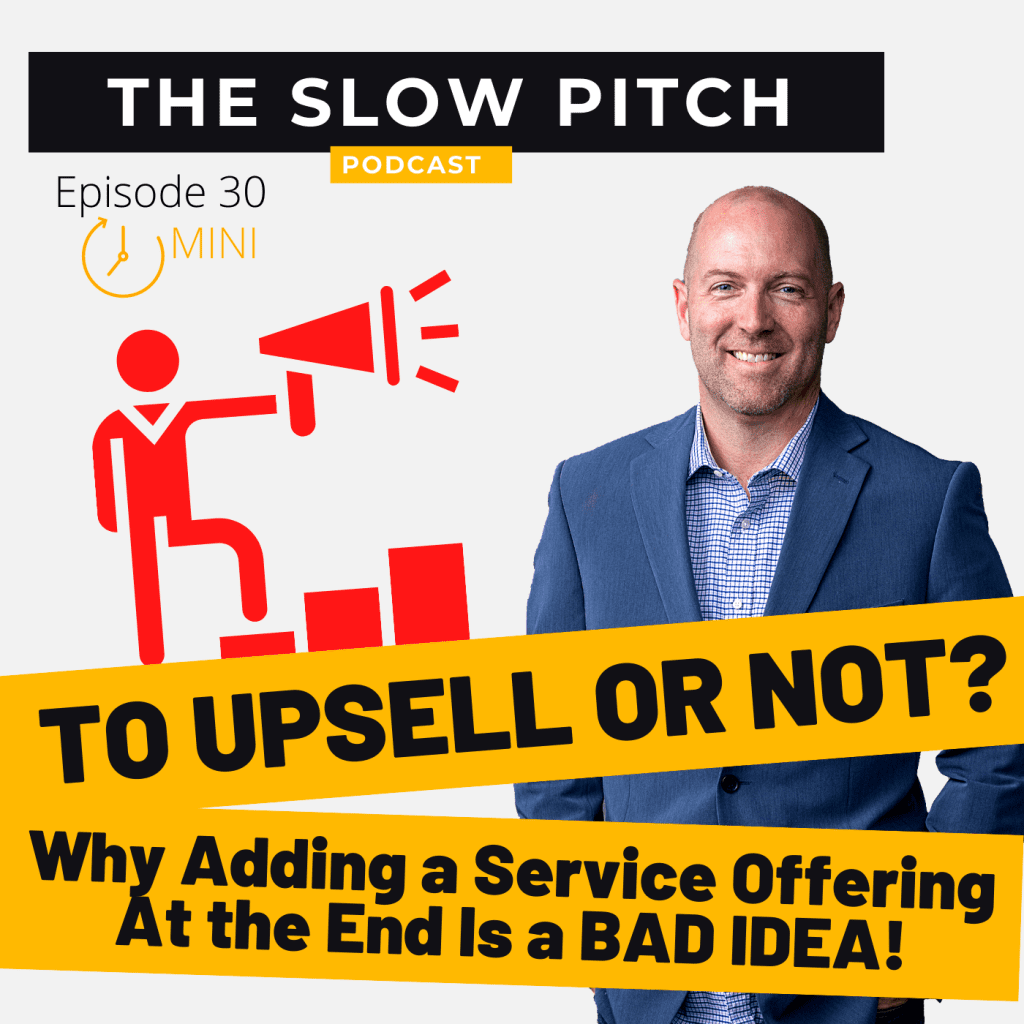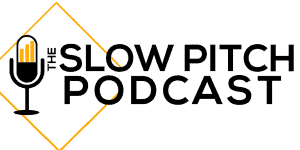When Should I Upsell, When Should I NOT Upsell?


Notes
NOTE: This is a mini episode! Short and to the point, but rich with information you can use.
When should I upsell?
This is a common question we get… When is a good time to upsell my products or services? Sometimes, it’s a great idea to upsell when they’re about to buy…but sometimes, you should not try to upsell. Here’s why:
There are a lot of factors that go into a sale and an upsell might just kill the deal. Would you rather get the sale and work on a long-term relationship/sale or get the extra cash. If you said, get the extra cash, it’s time you stop thinking that way. Sales is about relationships and the long-term. If you aren’t sure when you should upsell, I would like to share with you, during this mini episode one time when you should not upsell.
Upselling Without Losing The Sale
The time to upsell is much earlier in the sale…when you’re exploring all the pain points, understanding what they need, why they need it, etc. By attempting to interject an upsell near the end of the sales process, you’re doing yourself a disservice. You’ll probably lose the sale.
During the pain exploration portion of your conversation, you absolutely should upsell. That is when they are open to learning more about what you can do and what you’re going to do to solve their pain. If you’ve moved way past that and start to get to presenting your estimate/proposal, they’ve already settled on what they should expect in terms of pricing, time, etc. and do not want to be bother with an additional upsell or other services they haven’t heard of before.
Listen in as Rob shares when he almost messed up a deal by offering an upsell too late in the sale.
Related Episodes:
Top 10 Sales Tips For Beginners
How To Prepare For an Important Sales Meeting
How To Sell New Services (They Don’t Even Know They Need)
Related Articles:
When Should I Upsell My Customer?
Music: "Clydesdale Funk" by Cast of Characters, written by: Dustin Ransom.
The Episode
Rob 00:09
Welcome everybody to The Slow Pitch. And you’ll notice that this episode, Lane is missing. And here’s why. Sometimes, Lane and I have a difficult time getting together to make sure that we have an episode. And so rather than cheat you out of time and information, I thought it might be helpful for one of us to do a quick recording and send on an episode so that you get some information, something is better than nothing, right? So we thought it might be helpful to have one of us just record a little segment to give some information in between the times that we get a chance to have a conversation that said, here’s what happened this last week,
V/O 00:49
You were listening to The Slow Pitch Podcast, a podcast about selling less and closing more.
Rob 00:55
There was a situation where I had an opportunity to present a proposal or an estimate or presentation, however you want to call it, where we had gone through all the steps that we needed to go through to make sure that they were the right client or potential client. And in that process, I found out that, alright, they’re ready to buy. And so we kind of move to the next step. And as we move to the next step of the presentation process, we had decision makers, we knew the pain, we knew all the problems, we knew that this was going to be a good deal, it was gonna be affordable, we agreed on price, we did all that stuff. And as we got to the presentation, part of the whole program, what happened was, is I had this urge to share with this potential client, another service, I wanted to tell them, Hey, we can do this other thing for you, it’s only going to be a little bit more, right. And it’s so tempting, because they’re already ready to buy. And so you can, you can tell that you know that they’re ready to buy, why not just bring up another item that they can just buy right on the spot while you’re talking to them. I’m so glad that I refrained from doing that. And here’s why. As soon as you’re in that presentation step or in that step where you’re going to be giving, here’s our deliverables, here’s why it’s important to you, here’s the pain that you’re having. This is how we’re solving the pain, we know that the budget is this much blah, blah, blah, blah, blah, all the stuff that’s in the estimate. As soon as you get to that step, they’re ready to buy based on all of that information, if you add another item into it, that can significantly cloud their judgment. And they can change the course of what comes next. What could happen is they could just as well say, you know, that’s a different department, I need to check with Joe, or that’s a different area of our company and Mary needs to look at that before we can make any decisions suddenly you’re on hold. Or, you know, that brings us right over the budget and now I don’t know that we can do this. So there’s a whole bunch of things that can happen versus what is a sure thing. And that is you know that all the elements are in place, you know that they’re ready to buy, all that stuff is ready to go. That said, what do you do? Skip it! Don’t present the other stuff. Don’t add stuff in. Whenever somebody does that, to me when I’m buying, I always feel like I don’t know if I should make this decision right now. And a lot of people have that. But more importantly is that they get to make the decision based on all the stuff you guys have already talked about. So if you go through all of those elements and all the pain, you put together the estimate, and now you’ve got a well written out estimate, you go through that presentation, they make that decision after they make that decision to buy. That’s when you’re allowed to add stuff in. I don’t mean immediately while you’re still sitting at the table while they’re signing. What I mean is get them to sign start working on the process. And then as you get working together sometime early on your relationship, you might drop a question. That question might sound like, Hey, I just thought of something. I don’t know if you’d be interested in this at all. But this might be an area where we might be able to offer one other service just I just put it out there. I’m not expecting you to do anything with us now. But I just want to make sure you’re aware that this is something that we can do we do service “X” and give them a quick pain solving statement. So if you’re an IT company, and you also do web hosting, or you do file backups overnight, or whatever extra services you want to charge doesn’t really matter. You’re going to ask the question in such a way that sounds like, “Hey, you’re you’re probably not going to be interested in this, but I just want to make sure you’re aware of it.” And if you want to talk we can talk about it. And what you’re doing is what I call planting the seed. The seed gets planted, and then over a little bit of time what will happen is, whether it’s a day, a week, a month, that person that you’re speaking to, is going to go Hmm, this is something we may need. And overtime they may develop this… I think we need this and so then they may ask you the question. Hey a while back, you mentioned that you do this, can you tell me a little bit more about that now you’ve got to go through that sales process and find out if it’s worth their time worth their effort worth their money to do that, you help them work that just like you did before. But never ever add it to an estimate or to a presentation that you already have that solves the problems that they’ve had, that you’ve already talked about. And this is just coming up as a surprise on there. And if it’s coming up as a surprise in there, and you never talked about it, you never get into the weeds about it. You never talked numbers about it. This is not the time to bring it up. The time to bring it up is later if you’re working together. If you forgot, that’s your fault. That’s too bad. No worries, you’ll get it later. So just keep that in mind. So hopefully that will help you next time that you’re in a situation where you’re feeling like, man, I missed this piece and I want to add this in as a service. Unless you’re doing it for free. Don’t add it in and don’t bring it up because it’s not time. Wait till you’re working together. That’s when you can bring it up again in the form of a question that they can still say no to and no worries, just keep moving. So hopefully that helps. Until next time, we’ll see you guys later.
Rob 06:11
Thanks as always for listening today. If you like this podcast, please subscribe and leave us a review. We really appreciate it. Follow us on Twitter, Instagram and Facebook at The Slow Pitch. We were mixed today as always by Johnny Polokis. And we were produced by high gravity studios, music credits and other notes are in the show notes section on TheSlowPitch.com and we’ll be back with another episode soon.








